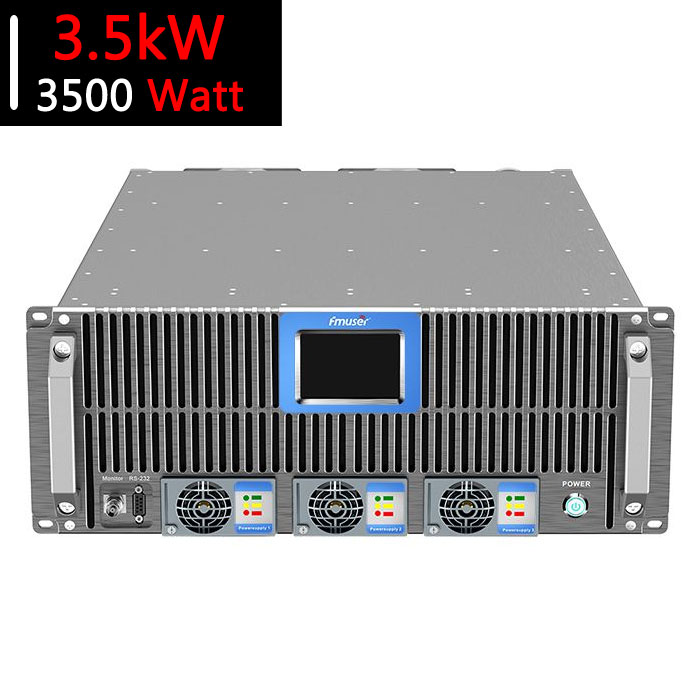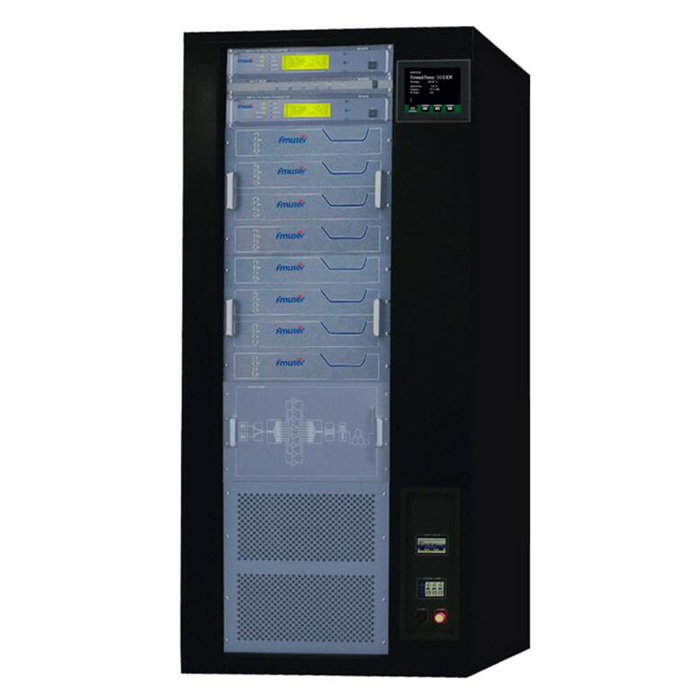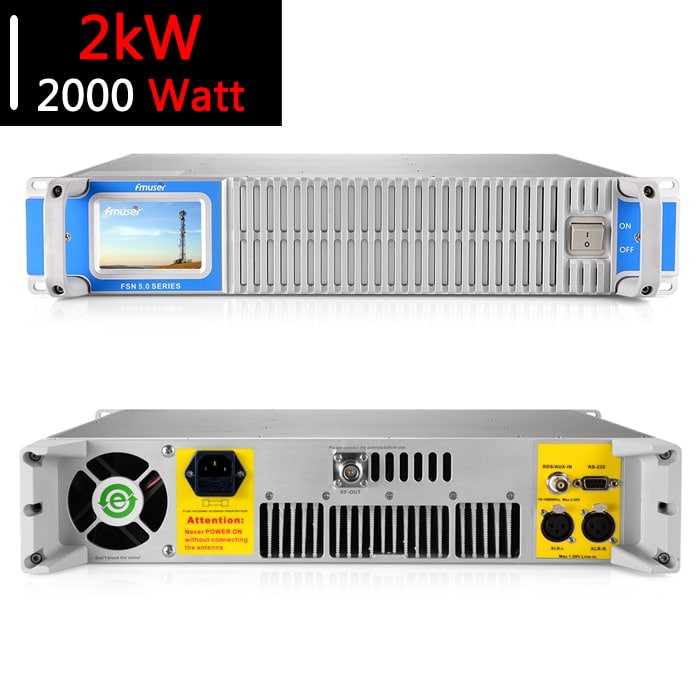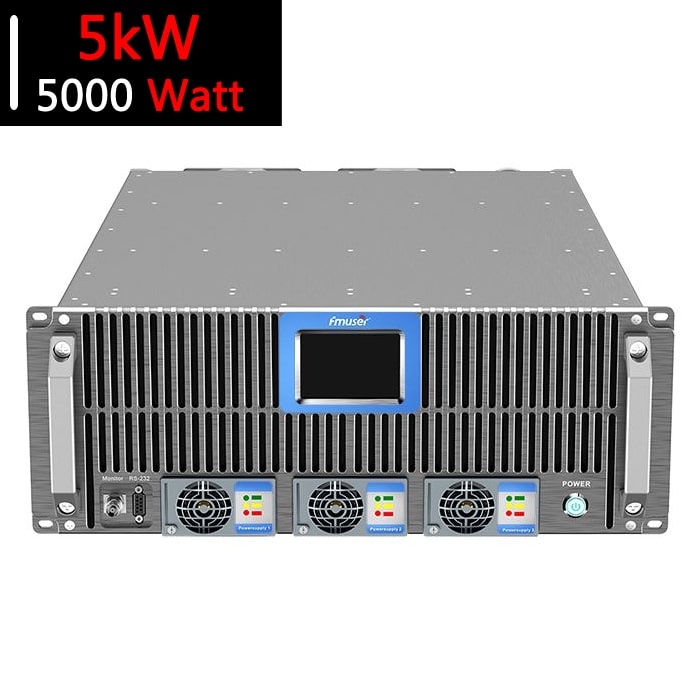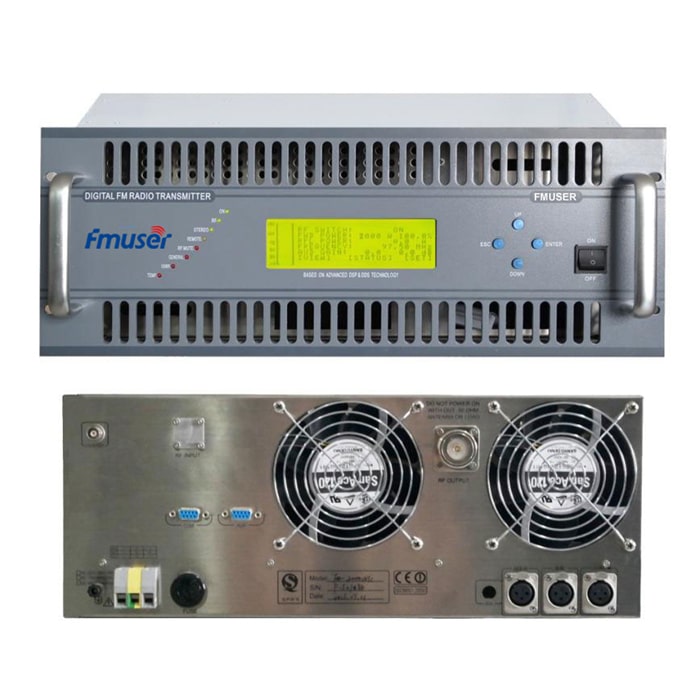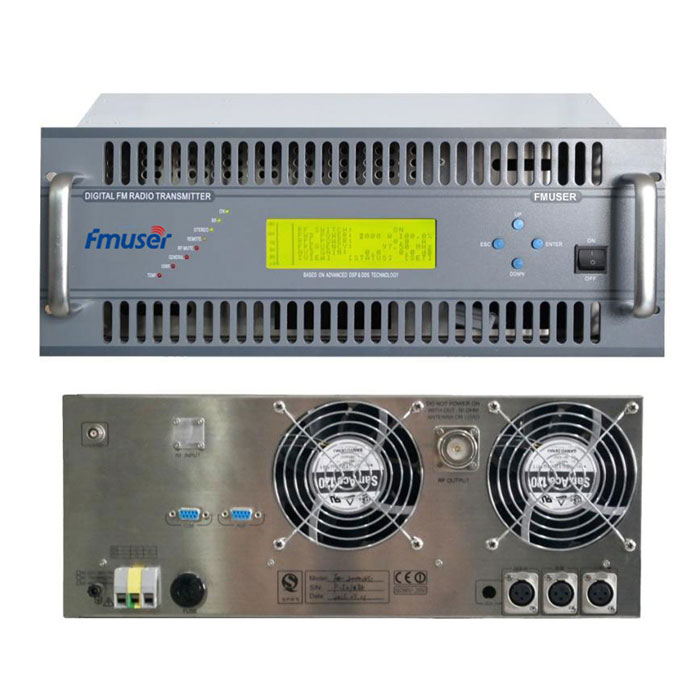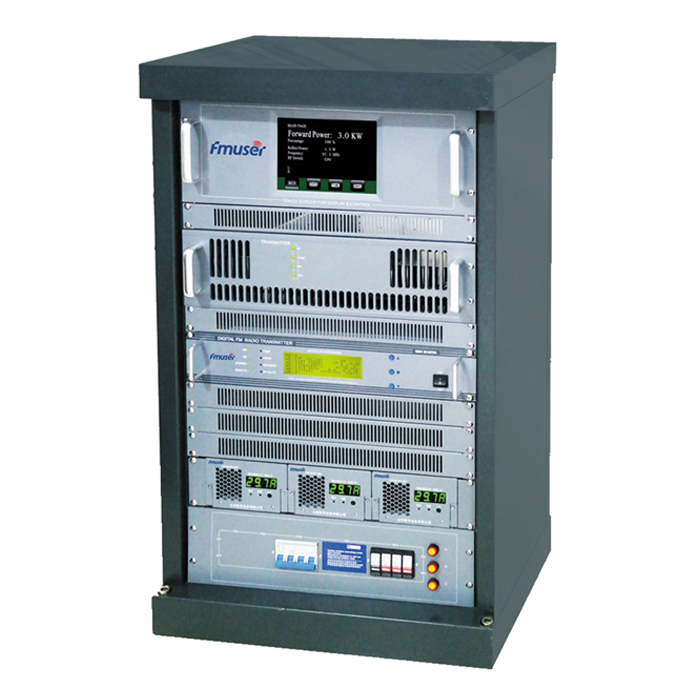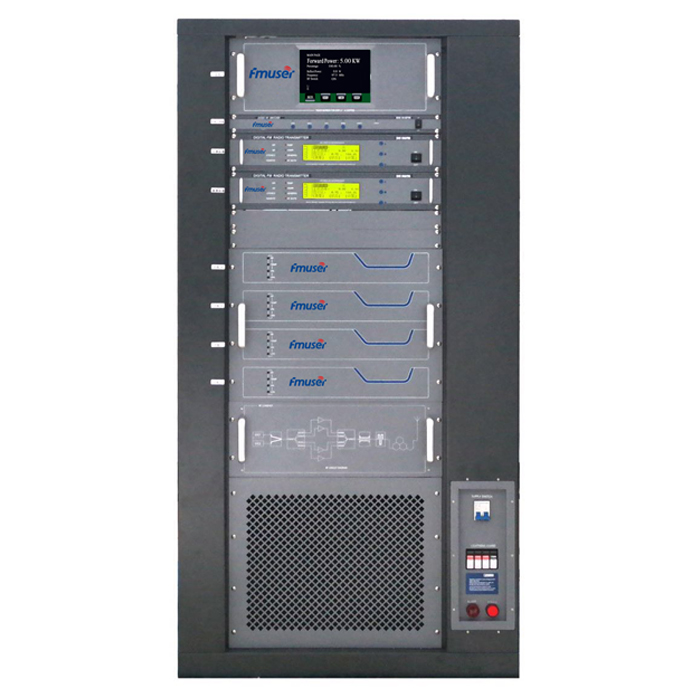
High Power FM Transmitters
High Power FM Transmitters are critical solutions for radio broadcasting, emergency communication, and large-scale audio distribution needs.
🚀 Unlocking Broadcasting Excellence: Why High Power FM Transmitters Matter
FMUSER specializes in cutting-edge RF technology, delivering transmitters trusted globally for reliability and performance. Our Classifications Page simplifies selection by categorizing products based on power output (300W to 20kW+), frequency range (87.5–108 MHz), and application-specific integrations, ensuring professionals in commercial broadcasting, disaster management, and community radio find tailored solutions effortlessly.
⚡ Engineered to Impress: Features That Redefine Performance
- Certified Durability: Built to meet FCC, CE, and RoHS standards for global compliance.
- Power Efficiency: Advanced cooling systems and switch-mode power supplies reduce energy costs by up to 40%.
- Smart Tech Integration: Adaptive DSP, remote monitoring, and dual-tower synchronization for uninterrupted broadcasts.
- Scalability: From 300W compact systems (ideal for startups) to 20kW+ industrial-grade transmitters for nationwide coverage.
🌍 Transform Your Reach: High Power FM Transmitters in Action
- Commercial Radio Broadcasting: FMUSER’s transmitters ensure crystal-clear audio and wide coverage for urban and rural networks, supported by fail-safe redundancy.
- Emergency Alert Systems: Rugged designs with backup power integration deliver critical updates during disasters, trusted by government agencies.
- Religious & Educational Networks: Affordable, easy-to-install systems enable nonprofits to broadcast sermons, lectures, and educational programs 24/7.
- International Broadcasters: Multi-frequency compatibility and OEM customization help stations comply with regional regulations while expanding listener bases.
✅ Why FMUSER? More Than Just a Supplier – We’re Your Partner
- Cost Advantage: Enjoy factory-direct pricing, with no middleman markup.
- Always Ready: Shipments within 24–72 hours – no delays, guaranteed.
- End-to-End Solutions: Turnkey packages include antennas, cabling, and remote control software for plug-and-play operation.
- Customization & Support: Request OEM designs, on-site installation, or pre-configured systems. Proven across South American, African, and Asian markets.
📋 Smart Buying Guide: How to Choose Your Perfect Transmitter
- 300W–1kW: Local/community radio | 2kW–5kW: Regional coverage | 10kW–20kW+: National networks.
- Verify Frequency Compliance: Ensure alignment with local regulatory bands (e.g., 88–108 MHz).
- Budget with ROI in Mind: Balance upfront costs with long-term savings from low power consumption and minimal maintenance.
-
![FMUSER 4U Compact 3000 Watt FM transmitter FSN-3500T for FM Radio Station]()
FMUSER 4U Compact 3000 Watt FM transmitter FSN-3500T for FM Radio Station
Price(USD):Ask for a quotation
Sold:86
-
![FMUSER Solid State 10000 Watt FM Transmitter FU618F for FM Radio Station]()
FMUSER Solid State 10000 Watt FM Transmitter FU618F for FM Radio Station
Price(USD):Ask for a quotation
Sold:18
-
![Compact 2U 2KW FM Transmitter FSN-2000T for FM Radio Station]()
-
![FMUSER 4U Compact 5KW FM Transmitter FSN-5000T for FM Radio Station]()
FMUSER 4U Compact 5KW FM Transmitter FSN-5000T for FM Radio Station
Price(USD):Ask for a quotation
Sold:44
-
![FMUSER Rack Mounted 2000 Watt FM Transmitter FU618F]()
-
![FMUSER FU618F Professional 2KW FM Transmitter 2U Rack Mounted for FM Radio Station]()
FMUSER FU618F Professional 2KW FM Transmitter 2U Rack Mounted for FM Radio Station
Price(USD):Ask for a quotation
Sold:69
-
![FMUSER Solid State 3000 Watt FM Transmitter FU618F]()
-
![FMUSER Solid State 5000 Watt FM Transmitter FU618F]()
- What is a high power FM transmitter?
- A high power FM transmitter is an electronic device that transmits radio waves with the intent of broadcasting an audio signal over a wide area. They typically have an output power of >1000w, which is significantly higher than the average power output of consumer FM radios. High power FM transmitters are used in radio and television broadcasting, as well as in the broadcasting of emergency and other public safety messages.
- How do you use a high power FM transmitter in a radio station?
- 1. Ensure you have the necessary permits and licenses to broadcast in your area.
2. Acquire a radio transmitter that is FCC approved and matches the requirements of your broadcast station.
3. Install the radio transmitter, making sure that all connections are properly secured and that the transmitter is properly grounded.
4. Set up your antenna system to ensure that your broadcast signal is properly broadcasted.
5. Connect the transmitter to your audio source and make sure the signal is strong and clear.
6. Set all necessary parameters within the transmitter to ensure the signal is broadcasted correctly.
7. Monitor the performance of the transmitter regularly to ensure that the signal is being broadcasted correctly and without interruption.
Problems to avoid:
1. Ensure that the transmitter is configured correctly and that any adjustments to the power output are done with care to avoid interference with other broadcast signals.
2. Make sure the antenna system is properly configured and that the signal is not being broadcasted too close to other broadcast signals, or within a restricted frequency range.
3. Avoid overheating of the transmitter which can cause transmission problems and reduce the lifespan of the equipment.
4. Monitor the signal output regularly to ensure that it is within permissible limits, and take appropriate corrective measures if necessary.
- How does a high power FM transmitter work?
- A high power FM transmitter in a broadcast radio station works by amplifying a radio signal to a higher power level than a standard transmitter. The amplifier is connected to an antenna, which transmits the amplified signal over a wide area. The signal is then picked up by FM receivers in the area, allowing listeners to hear the broadcast.
- Why a high power FM transmitter is important for a radio station?
- A high power FM transmitter is important for a broadcast radio station because it allows for a wider broadcast range and better signal strength over a larger geographical area. This is especially important for radio stations that serve rural or remote areas, or for those that have a higher audience ratings goal. A high power transmitter is also necessary for a broadcast radio station as it is the only way to reach the required coverage area.
- What are the most-seen output power of a high power FM transmitter, and how far can they cover?
- The most common output power for a high power FM transmitter is typically between 1 kW and 50 kW. Depending on the antenna height, terrain, and other factors, these transmitters can cover distances up to 50 miles or more.
- How to step-by-step build up a complete FM radio station with a high power FM transmitter?
- 1. Research and obtain a license from the FCC to legally broadcast your FM radio station.
2. Choose a location for the FM transmitter and antenna. Make sure the location meets all FCC requirements.
3. Acquire the necessary equipment, such as an FM transmitter, antenna, tower, and other accessories.
4. Install the FM transmitter and antenna.
5. Connect the FM transmitter to a power supply and an audio source.
6. Tune the FM transmitter to the desired frequency.
7. Test the signal strength and quality of your broadcast.
8. Regularly maintain and inspect your FM transmitter and antenna to make sure everything is working properly.
9. Keep your FCC license up to date and in compliance with all regulations.
- How far can a high power FM transmitter cover?
- It depends on the type of transmitter and a variety of other factors, such as the height of the transmitter and the terrain of the area. Generally speaking, a high-power FM transmitter can cover anywhere from 5 to 100 miles or more.
- What determines the coverage of a high power FM transmitter and why?
- The coverage of a high power FM transmitter is determined by the height of the antenna and the power of the transmitter. The higher the antenna and the more powerful the transmitter, the farther the signal can travel. The coverage also depends on the type of terrain the signal is passing through. If the terrain is flat, the signal can travel farther than if the terrain is mountainous. The coverage can also be affected by other radio signals in the area, which can interfere with the desired signal.
- How do you improve the coverage of a high power FM transmitter?
- Step 1: Check the antenna's VSWR. The VSWR should be below 2:1. If not, then adjust the antenna system to reduce the VSWR.
Step 2: Install a directional antenna. Directional antennas can focus the signal in one direction, increasing the signal coverage in that area.
Step 3: Install a high power amplifier. High power amplifiers will increase the wattage of the signal, which will increase the coverage.
Step 4: Install a booster antenna. Booster antennas can help to amplify the signal, increasing the coverage area.
Step 5: Install a high pass filter. A high pass filter can help to reduce interference from other stations, increasing the signal coverage.
Step 6: Optimize the transmitter's settings. This includes adjusting the power level, modulation, frequency, bandwidth, etc. to maximize the coverage.
Step 7: Monitor the signal coverage regularly. This will help you to identify any areas where coverage is weak and then adjust the transmitter settings accordingly.
- How many types of high power FM transmitters are there?
- There are three main types of high power FM transmitters (>1000w): analog FM transmitters, digital FM transmitters, and DAB+ FM transmitters. Analog FM transmitters are the most widely used type of radio transmitters and they typically offer the highest sound quality. Digital FM transmitters are used for digital radio broadcasts, which are becoming increasingly popular due to their higher sound quality. DAB+ FM transmitters are used for digital audio broadcasts and they offer the highest sound quality. The main differences between each type of transmitter are in the type of technology used and the sound quality they offer.
- How do you choose the best high power FM transmitters for a a broadcast radio station?
- When choosing a high power FM transmitter for a broadcast radio station, it is important to consider several factors. First, you should evaluate the transmitter's power output to make sure it is sufficient for your needs. Secondly, consider the features and ease of use of the transmitter. Thirdly, research the quality of the components used in the transmitter and the company's reputation. Finally, check the transmitter's price to make sure it fits within your budget. By carefully evaluating these factors, you can make an informed decision and choose the best high power FM transmitter for your broadcast radio station.
- How do you correctly connect a high power FM transmitter?
- 1. Disconnect your main transmitter from the antenna.
2. Install the new high power FM transmitter and connect it to the transmitter antenna.
3. Connect the transmitter to the station's audio chain using audio cables.
4. Connect the power supply for the transmitter and make sure it is properly grounded.
5. Connect the transmitter to the station's monitoring system to ensure that it is working correctly.
6. Connect the transmitter's control system to the station's automation system.
7. Set up a suitable antenna system for the transmitter.
8. Check all the connections, power up the transmitter, and test the system.
- What other equipment do I need to start a a broadcast radio station, apart from a high power FM transmitter?
- To start an FM radio station, you will need the following equipment in addition to a high power FM transmitter:
1. Antenna: This will be used to broadcast the signal from your transmitter to the surrounding area.
2. Studio Equipment: This includes microphones, mixers, audio processors, computers, and other related equipment for producing the audio content for your station.
3. Audio Playback Equipment: This includes audio players and other equipment necessary for playing music and other audio content on the air.
4. Audio Storage: This includes hard drives and other storage devices for recording and storing audio content.
5. Audio Editing Software: This software will be used for creating and editing audio content for your station.
6. Broadcast Automation Software: This software controls the automation of the broadcast, allowing you to play music, commercials, and other audio content on a regular schedule.
7. Radio Automation System: This includes the hardware and software necessary for running the radio automation system.
8. Radio Transmitter: This is used to transmit the audio signals from your station to the radio listeners in your area.
- What are the most important physical and RF specifications of a high power FM transmitter?
- The most important physical and RF specifications of a high power FM transmitter include RF power output, frequency range, efficiency, gain, harmonic distortion, intermodulation distortion, spurious emissions, frequency stability, modulation capability, audio inputs, RF input, RF output impedance, cooling system, and power supply requirements.
- How do you correctly maintain a high power FM transmitter?
- 1. Inspect the transmitter for any signs of damage or wear. Check all connections and cables for any loose or frayed ends.
2. Test the transmitter output using a wattmeter and an FM modulator to ensure that it is delivering the correct power level.
3. Ensure that the air gap between the transmitter and the antenna is correctly adjusted and that it is free of any obstructions.
4. Check the RF filter to ensure that it is properly tuned and that all connections are secure.
5. Check the cooling system to ensure that it is functioning correctly and that there are no obstructions in the fan.
6. Monitor all power levels and other technical parameters to ensure that the transmitter is operating within the manufacturer's specifications.
7. Adjust the transmitter modulation levels to ensure that they remain within acceptable levels.
8. Perform regular maintenance on any auxiliary equipment, such as the audio processor, to ensure that it is operating correctly.
9. Record all readings and maintenance activities in a logbook for future reference.
- How do you repair a high power FM transmitter if it fails to work?
- The first step in repairing a high power FM transmitter is to identify what is causing the failure. This can be done by checking the power supply, checking the wiring, and inspecting the components for damage. Once the cause has been identified, it is important to replace any broken or damaged components. This can be done by purchasing new parts or by finding replacement parts from a radio repair shop. Finally, the transmitter should be tested to ensure that it is back in working condition.
- What is the basic structure of a high power FM transmitter?
- The basic structure of a high power FM transmitter consists of an RF amplifier, a modulator, a power amplifier, an RF combiner, and an antenna.
The RF amplifier amplifies the signal for transmission. The modulator shapes the signal and adds the audio that is to be transmitted. The power amplifier boosts the signal for transmission. The RF combiner combines the signals from the power amplifier and the modulator and feeds it to the antenna.
The power amplifier determines the attributes and performance of the transmitter. Without the power amplifier, the other components may still work, but the signal will not be powerful enough to be broadcasted.
- Who should be assigned to manage a drive in FM transmitter?
- In a broadcast station, the person assigned to manage a high power FM transmitter should be an experienced broadcast engineer with a thorough understanding of radio broadcast technology. This person should possess excellent technical skills and knowledge, problem-solving skills, strong attention to detail, and the ability to troubleshoot complex equipment. Additionally, the person should have excellent communication skills and the capability to understand and follow safety protocols and procedures.
- How are you?
- I am fine
CONTACT US


FMUSER INTERNATIONAL GROUP LIMITED.
We are always providing our customers with reliable products and considerate services.
If you would like to keep touch with us directly, please go to contact us
